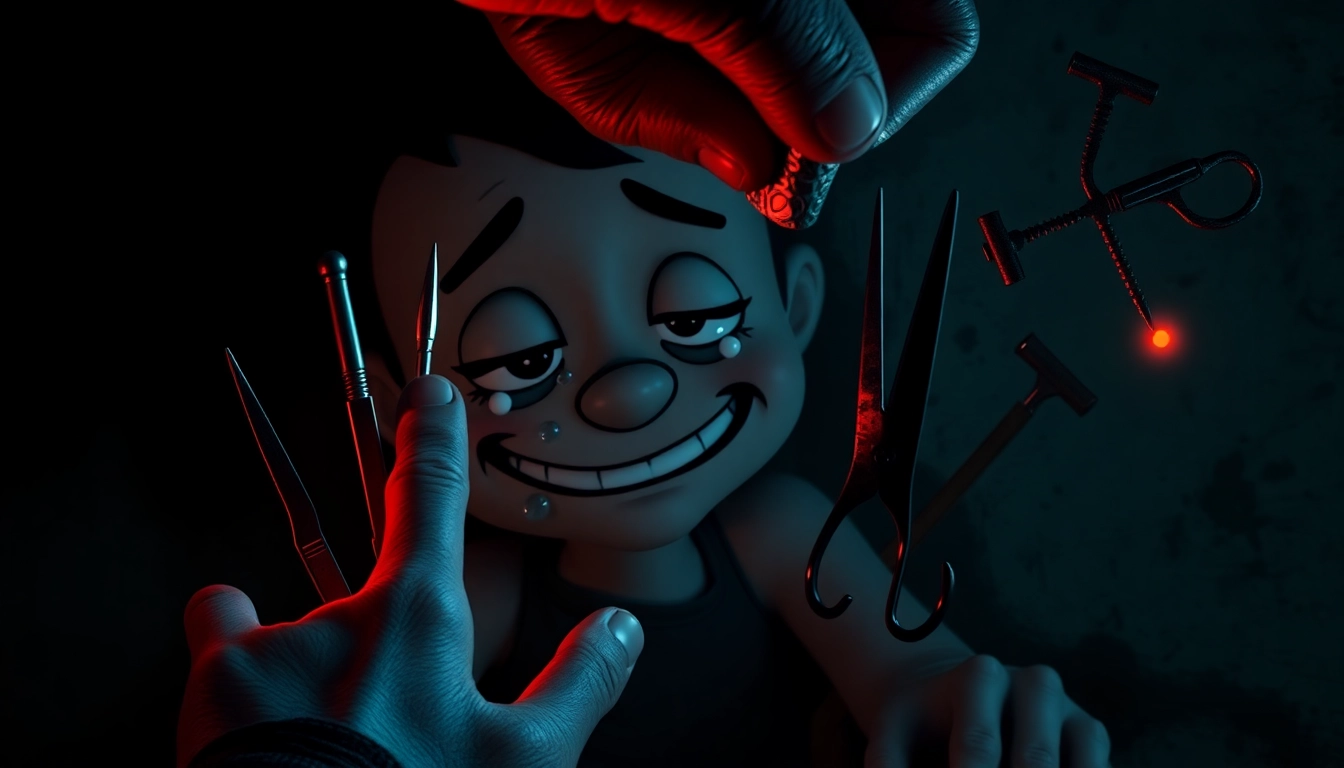Overview and Context: BloodMoney — A Dark Psychological Clicker Experience
In the realm of psychological horror gaming, few titles manage to confront players with such visceral moral dilemmas as bloodmoney. This dark clicker game plunges players into a disturbing universe where each interaction, each click, becomes a test of morality, resilience, and human decency. The core mechanic revolves around clicking on a cheerful character named Harvey, whose innocent appearance hides a more sinister role: generating vital funds for a desperate medical condition. The game’s power lies not only in its unsettling visuals but also in how it intricately weaves gameplay with a harrowing narrative, forcing players to confront uncomfortable questions about the cost of survival and the nature of human morality.
The Dark Narrative of BloodMoney and the Harvey Community Insights
BloodMoney’s story is deceptively simple: You are diagnosed with a life-threatening condition that requires $25,000 for treatment. Time is against you, and options are limited. Enter Harvey, a seemingly cheerful and naive character who offers a bizarre solution — click on him to generate money. What starts as an innocent game of tapping quickly spirals into a moral abyss, as each click causes Harvey pain, and the game’s shop offers increasingly violent tools for profit maximization. The community surrounding bloodmoney is deeply engaged with its complex moral narrative. Players share insights about how their choices influence endings, with some emphasizing the emotional toll of their decisions, while others explore the philosophical implications of exploiting Harvey’s suffering. Many fans note Harvey’s innocent demeanor, which starkly contrasts with the violent tools available for purchase, highlighting the game’s commentary on human nature and the capacity for cruelty under extreme circumstances.
Featured Gameplay Videos and Community Reactions
To better understand the dark allure of bloodmoney, many players turn to gameplay videos that reveal the game’s layered mechanics and narrative depth. These videos often showcase players navigating the moral maze, experimenting with different upgrades, and reaching various endings. For example, some videos demonstrate how choosing minimal harm preserves Harvey’s innocence but prolongs the game, while others push the limits, selecting tools like hammers or knives to maximize earnings at Harvey’s expense. The community’s reaction to these choices is overwhelmingly intense—viewers often express a mix of fascination and discomfort, reflecting on their own moral boundaries. These videos serve as a window into the game’s unsettling atmosphere and provoke discussions about the psychological impact of such morally charged gameplay experiences.
Clicking Mechanics and How They Drive the Narrative
The core gameplay loop of bloodmoney hinges on clicking Harvey repeatedly to generate funds. Initially, each click seems harmless—just a simple interaction, a quick tap. However, as the game progresses, the cumulative effect of these clicks begins to reveal a disturbing pattern: Harvey’s pain and suffering escalate with every interaction. The game’s design cleverly uses visual cues—Harvey’s increasingly distressed expressions, subtle dialogue shifts, and deteriorating surroundings—to underscore the moral decay taking place. The clicking mechanic is not merely about the accumulation of money; it’s a visceral experience that forces players to ask themselves how much suffering they are willing to inflict for survival. The tension is heightened by the game’s time pressure—players must reach the $25,000 target before the clock runs out, adding urgency to their moral choices.
Upgrade System: From Needles to Hammers
As players advance, the shop becomes a focal point for moral compromise. Initially, the upgrades are innocuous—adding a needle for more precise, less violent clicks. But the game’s darker side quickly emerges as more violent tools become available. The choice of upgrades profoundly impacts the gameplay experience and the moral narrative. Choosing a needle might symbolize minimal harm, aligning with a more compassionate approach, while selecting a hammer or a knife signifies a willingness to maximize profit regardless of Harvey’s suffering. Interestingly, players have observed that Harvey often appears surprised by the more violent tools, implying he might not fully understand what’s in the shop—adding a layer of moral ambiguity. These upgrades come with visual consequences; Harvey’s reactions and appearance change, reflecting the psychological toll of each decision.
The Psychological and Visual Impact of Upgrades
The game’s art direction amplifies the unsettling atmosphere—Harvey’s expressions shift from cheerful to distressed, and the environment darkens as violence escalates. Each upgrade not only influences the earning rate but also deepens the moral abyss. For instance, using a hammer results in more money but leaves Harvey visibly injured and terrified. The visual cues, combined with disturbing sound design, create a visceral experience that intensifies players’ moral discomfort. This duality—between the desire for financial gain and the horror of Harvey’s suffering—serves as a powerful commentary on human nature and the choices we make when pushed to our limits.
Multiple Pathways and Endings: Morality vs. Efficiency
BloodMoney offers three distinct endings, each reflecting different moral stances: The Good Ending, the Normal Ending, and the Bad Ending. These outcomes are not predetermined but are shaped by player choices throughout the game. Minimal harm approaches, such as opting for less violent tools, tend to lead to the Good Ending, where Harvey’s suffering is minimized, and the player’s moral integrity remains relatively intact. Conversely, embracing violent upgrades like the hammer or knife propels players toward the Bad Ending, characterized by Harvey’s severe injury and despair. The Normal Ending sits somewhere in the middle, achieved by mixed choices that balance profit with some compassion. The game’s subtle tracking of player behavior ensures that even choices not directly linked to violence influence the final outcome, emphasizing how every action—big or small—shapes the narrative.
The Desperate Situation: A Moral Crossroads
The core premise of bloodmoney is rooted in desperation. Diagnosed with a serious health condition, players are faced with the brutal reality of their situation: survival at any cost. The game encapsulates this tension beautifully, illustrating how extreme circumstances can distort moral boundaries. The offer from Harvey, seemingly innocent at first, becomes a symbol of this moral dilemma. Do you prioritize your financial survival, risking Harvey’s pain and suffering? Or do you resist the temptation of quick gains and preserve some moral dignity? The narrative’s power lies in this choice, forcing players to confront their own values and limits in a visceral way.
Harvey’s Proposition and the Player’s Moral Descent
Harvey’s cheerful demeanor is a stark contrast to the gruesome tools and escalating suffering. His innocence, coupled with his apparent lack of understanding about the true nature of the shop’s items, adds complexity to the moral questions. As the game progresses, Harvey’s reactions—fear, pain, confusion—become more pronounced, echoing the player’s own moral descent. The player’s choices, especially regarding the violence inflicted upon Harvey, mirror the broader human dilemma of whether ends justify means. The game smartly leaves room for interpretation: Is Harvey just a pawn, or does he represent innocence that’s being exploited? This ambiguity enhances the psychological horror, making each decision a profound reflection on human morality.
Hidden Depths and Subtle Details
One of the most fascinating aspects of bloodmoney is the subtlety of its storytelling. Observant players have noted Harvey’s surprise reactions to violent tools, suggesting he might not fully comprehend what’s happening. For example, when offered a knife or hammer, Harvey’s expressions of shock or fear imply he may think he’s receiving harmless items—like pillows or toys—highlighting the game’s commentary on innocence and deception. These small details deepen the moral complexity, prompting players to question whether their actions are truly malicious or simply driven by desperation. The game’s layered storytelling encourages multiple playthroughs, each revealing new insights into Harvey’s character and the broader themes of morality, innocence, and corruption.
The Final Choice: Your Moral Fate and Endings
As you approach your $25,000 goal, the game’s climax hinges on your choices—how much suffering you’re willing to inflict and how many violent upgrades you select. The culmination is a final decision that determines which ending you receive. The Good Ending involves minimizing Harvey’s suffering, perhaps even refusing some upgrades, and demonstrating a moral restraint. The Normal Ending involves a compromise—accepting some violence but balancing profit with compassion. The Bad Ending, the most disturbing, is achieved through relentless pursuit of profit at any cost, resulting in Harvey’s severe injury and despair. Each ending serves as a reflection of the player’s moral stance, making bloodmoney not just a game of clicks but a profound moral experiment. The game leaves a lasting impression, prompting reflection on our own boundaries and the nature of humanity in extreme situations.
Community Insights and Thematic Depth
The bloodmoney community is highly active, dissecting every detail of the game’s narrative, mechanics, and moral implications. Many players discuss how their choices influenced their endings, with some expressing regret or moral conflict. Discussions often revolve around Harvey’s innocence, the symbolism of the violent tools, and the game’s commentary on human greed and desperation. Some fans theorize that Harvey represents the last vestiges of innocence in a corrupt world, and the game’s dark tone acts as a mirror to real-world issues of morality under stress. These insights enrich the gameplay experience, transforming it from simple entertainment into a profound philosophical exploration.
The Reflection of Human Nature and Morality
BloodMoney’s strength lies in its ability to encapsulate the duality of human nature. On one hand, players are driven by a primal instinct to survive and succeed; on the other, they confront the moral costs of their actions. The game challenges the assumption that morality is fixed, instead suggesting it is fluid and context-dependent. Harvey’s innocence contrasts sharply with the violent tools, creating a powerful visual and emotional dichotomy. The game asks: Are we inherently good or evil? Or do circumstances reveal our true nature? BloodMoney’s layered narrative and ambiguous ending leave players contemplating these questions long after the game ends, making it a landmark in psychological horror and moral storytelling.
Design Choices and Atmosphere
BloodMoney’s unsettling atmosphere is crafted through meticulous visual and auditory design. The subtle changes in Harvey’s expressions, combined with dark, oppressive environments, create a sense of dread and moral unease. The sound design amplifies this tension—distorted whispers, painful sounds during Harvey’s suffering, and disturbing music contribute to an immersive experience. The deliberate pacing—gradually increasing violence and moral stakes—keeps players engaged and emotionally affected. The game’s art direction, with its stark contrasts and disturbing imagery, reinforces themes of innocence lost and moral corruption, making every click a moment of moral reflection.
Why BloodMoney Stands Out in Psychological Horror Gaming
Unlike traditional horror games that rely on jump scares or gore, bloodmoney immerses players in a slow-burning, thought-provoking nightmare. Its focus on moral choices and psychological torment, coupled with minimalist gameplay mechanics, sets it apart in the genre. The game’s ability to evoke genuine emotional responses—guilt, shame, discomfort—demonstrates its mastery of psychological horror. It pushes players to confront their own moral boundaries, making it not just a game but a mirror to the darker aspects of human nature. Its impact is amplified by community discussions, gameplay analyses, and the enduring curiosity about the multiple endings and hidden depths.
Conclusion: Confronting Our Moral Limits Through Gaming
BloodMoney is more than just a disturbing clicker game; it is a profound exploration of morality, desperation, and human nature. Playing through Harvey’s ordeal forces players to examine their own boundaries—how much suffering they are willing to accept or inflict for survival. Its layered narrative, subtle storytelling, and unsettling atmosphere make it a standout in psychological horror. The game challenges us to reflect on the true cost of our choices and the darkness that can reside within us all. As you navigate this moral maze, remember the profound message at its core: how far are you willing to go when your life is at stake? For those intrigued by the depths of human morality and the power of interactive storytelling, BLOODMONEY offers an unforgettable, haunting experience.
Discover more about this unsettling journey and explore the moral depths of BLOODMONEY by visiting bloodmoney. Will you choose mercy, or will you succumb to the darker urges driven by desperation? The choice is yours, and each click echoes your moral fate.



